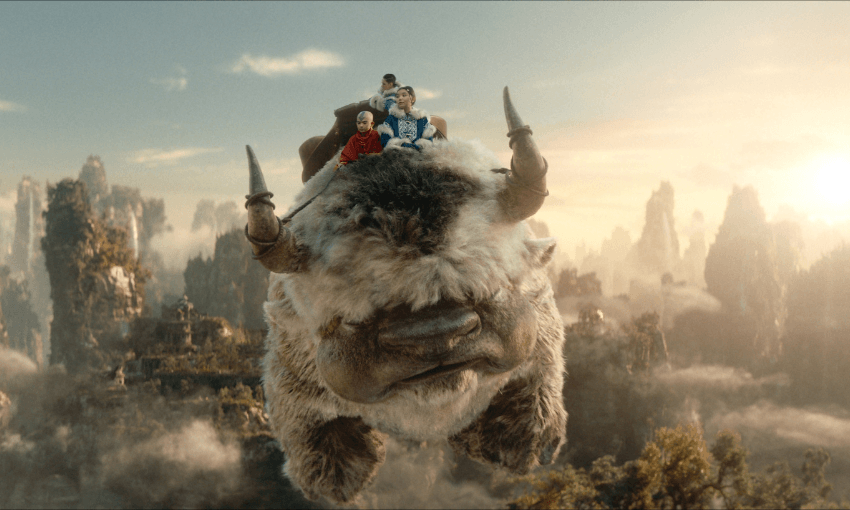The last live-action Avatar remake left a lot to be desired. Can the new Netflix reboot of the legendary cartoon series make up for it?
Avatar: The Last Airbender is a fantasy show set in a world with four elemental nations – the Air Nomads, Fire Nation, Earth Kingdom and Water Tribe – where some humans (benders) can control their national element using martial arts (bending). Only the Avatar, an Air Nomad boy named Aang, can wield all four elements and bring balance to the world. He teams up with other youngsters of diverse nationalities to stop the Fire Nation’s cataclysmic colonial conquest.
Superficially, this show follows a group of children saving the world. But look more deeply and you’ll find mature themes like colonisation, death, genocide and war – heavy topics for a so-called kids’ show. Nickelodeon’s original ATLA cartoon spawned an equally excellent and mature sequel, The Legend of Korra, and a third cartoon is in the works. But the first live-action Avatar attempt, M. Night Shyamalan’s 2010 film, was atrocious – it has a Rotten Tomatoes critics’ rating of just 5% (extremely rotten).
Given that, you can understand Avatar aficionados’ hesitancy when Netflix announced they were remaking ATLA into a live-action TV show. Those worries were exacerbated when the cartoon’s creators, Bryan Konietzko and Michael Dante DiMartino, left Netflix’s project over creative differences. Now the remake is out, were fans right to be worried?
The good
The costumes, settings and music of the show are all impeccable. The city of Omashu in particular, a Lord of the Rings-esque magnificent mountainous city, left me gobsmacked. The benefit of live action over cartoon is being able to see so many more intricate little details. In the cartoon, the protagonist Aang has solid blue arrow tattoos. But in Netflix’s remake, inside the tattoos are elaborate detailing, and older ones look faded, while fresher tattoos are sharper.
Alongside the show’s amazing costuming and locations, the cartoon’s loveable characters have translated to live action well thanks to some excellent casting choices. Ian Ousley as the awkward but courageous Sokka, and Maria Zhang, as the badass wahine toa Suki, are particularly well-cast. While the same great relationship dynamics and character arcs of the cartoon are at play in this remake, the reboot adds refreshing new dimensions to spice up old characters while maintaining their overall spirit.
The aesthetics of bending (controlling air, earth, fire or water using martial arts) has also been hugely improved compared to M. Night Shyamalan’s film. My favourite scene from the first three episodes featured firebenders blast flames out of their hands to fly, Iron Man style. The fighting scenes are generally well-choreographed with fluid and natural martial arts, but they are also much more violent than in the cartoon (several scenes include firebenders burning people to death).
Aside from the show itself, the reboot’s behind-the-scenes mahi is also worth highlighting. Unlike the original cartoon, the actors and filmmakers behind this remake of an Asian-inspired show are themselves Asian – including New Zealand director and producer Roseanne Liang, who’s episodes are arguably season one’s best.
The bad
If you’re looking for an exact scene-by-scene recreation of the original cartoon, you’re in for a shock. There are distinct character, story and storytelling differences between Netflix’s new version and Nickelodeon’s classic cartoon. One noticeable change is that the iconic opening sequence spiel – “Water. Earth. Fire. Air. Long ago, the four nations lived together in harmony. Then, everything changed when the Fire Nation attacked…” – only happens in the first episode.
Other parts of the show which are faithful recreations of the cartoon come off as really cheesy in live-action. Hearing a salesman passionately screaming about the destruction of his cabbage cart definitely lands better in the cartoon, for example. The third episode in particular has some very cringey lines of dialogue and sequences which had me gritting my teeth.
Although bending and combat are majorly improved compared to M. Night Shyamalan’s film, I think they will always look better with a cartoon’s artistic freedom compared to live-action. One small detail I miss from the cartoon is the subtle screen shake when earth bending occurs.
Additional critiques include Aang sometimes looking jarring in live-action with his orange clothes and bright blue tattoos, and, because the cartoon’s 20-episode first season was condensed into 8 live-action episodes, some actions and dialogue that progress the story feel forced.
The verdict
Despite the occasional cheesiness, this latest Avatar reboot is a good watch and a faithful adaptation of Nickelodeon’s classic cartoon that tells the same epic story and excellent character arcs – while standing on its own two feet by adding new story elements and character details. The emotional undercurrents of the cartoon can be hit or miss in live-action, but several moments here brought a tear to my eye.
Arguably, the greatest-ever fantasy TV show reboot is the 2000s remake of the 1970s sci-fi cult classic Battlestar Galactica which, much like the Avatar reboot, took the essence and overarching story of its predecessor but updated specific details about the world and the characters. As a longtime ATLA fan who has rewatched the cartoon many times, I don’t just want to see the exact same story retold in live-action.
At the end of the day, cheesiness is part of the ATLA story. The whole premise of the show – a group of kids saving the world – is corny to the core. Avatar’s more mature themes, like how to overcome the pain caused by the loss of loved ones, balance out the odd cringey moment.
Avatar’s overall concern is how the responsibility is on youth to solve problems caused by older generations, which provides an excellent example for today’s climate-anxious rangatahi. If it takes a bit of cheesiness to get such an important message across, so be it.
Avatar: The Last Airbender is on Netflix now. The reviewer watched the first three of eight episodes for this review.



